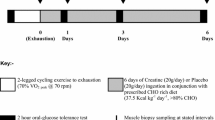Summary
Treadmill exercise in Thoroughbred horses of 2 min duration and increasing intensity resulted in increased formation and accumulation of acetylcarnitine in the working middle gluteal muscle. At high work intensities a plateau in acetylcarnitine formation was reached corresponding to approximately 70% of the total carnitine pool (approx. 30 mmol · kg−1 dry muscle). Formation of acetylcarnitine was mirrored by an equal fall in the free carnitine content, which stabilised, at the highest work intensities, at around 8 mmol · kg− dry muscle. Acetylcarnitine and carnitine reached their point of maximum change at a work intensity just below that resulting in the rapid production and accumulation of lactate and glycerol 3-phosphate. It is possible that the formation of acetylcarnitine is important in the regulation of the intramitochondrial acetyl CoA/CoA ratio; equally these changes may represent a blocking mechanism aimed at preventing the transfer of unwanted free fatty acids (as acylcarnitines) into the mitochondria at work intensities where they could contribute little to energy production.
Similar content being viewed by others
References
Alkonyi I, Kerner J, Sandor A (1975) The possible role of carnitine and carnitine acetyl-transferase in the contracting frog skeletal muscle. FEBS Lett 52:265–268
Bergstrom J (1962) Muscle electrolytes in man. Determined by neutron activation analysis on needle biopsy specimens. A study on normal subjects, kidney patients, and patients with chronic diahorrea. Scand J Clin Lab Invest [Suppl 68] 14
Bieber LL (1988) Carnitine. Annu Rev Biochem 57:261–283
Bookleman H, Trijbels JMF, Sengers RCA, Hanssen AJM, Veerkamp JH, Stadhouders AM (1978) Pyruvate oxidation in rat and human skeletal muscle mitochondria. Biochem Med 20:395–403
Brecher P (1983) The interaction of long chain acylCoA with membranes. Mol Cell Biochem 237:3–15
Carter AL, Lennon DLF, Stratman FW (1981) Increased acetylcarnitine in rat skeletal muscle as a result of high-intensity short-duration exercise. FEBS Lett 126:21–24
Childress CC, Sacktor B, Traynor DR (1966) Function of carnitine in the fatty and oxidase-deficient insect flight muscle. J Biol Chem 242:754–760
Christiansen RZ, Bremer J (1976) Active transport of butyrobetaine and carnitine into isolated liver cells. Biochim Biophys Acta 448:562–577
Foster CVL, Harris RC (1987a) Changes in free and bound carnitine in muscle with maximal sprint exercise in the Thoroughbred horse. In: Gillespie JR, Robinson NE (eds) Equine exercise physiology 2. ICEEP, California, pp 332–340
Foster CVL, Harris RC (1987b) Formation of acetylcarnitine in muscle of horse during high intensity exercise. Eur J Appl Physiol 56:639–642
Garland PB, Randle PJ (1964) Control of pyruvate dehydrogenase in the perfused rat heart by the intracellular concentration of acetyl-isoenzyme A. Biochem J 91:6c-7c
Harris RC, Hultman E, Nordesjo LO (1974) Glycogen glycolytic intermediates and high energy phosphates in biopsy samples of musculus quadriceps femoris of man at rest. Methods and variance of values. Scan J Clin Lab Invest 33:109–120
Harris RC, Foster CVL, Hultman E (1987a) Acetylcarnitine formation during intense muscular contraction in humans. J Appl Physiol 63:440–442
Harris RC, Harman J, Marlin DJ, Snow DH (1987b) Acute changes in the water content and density of blood and plasma in the thoroughbred horse during maximal exercise: relevance to the calculation of metabolite concentrations in these tissues and in muscle. In: Gillespie JR, Robinson NE (eds) Equine exercise physiology 2, California, pp 464–475
Harris RC, Marlin DJ, Snow DH (1987c) Metabolic response to maximal exercise of 800 m and 2000 m in the thoroughbred horse. J Appl Physiol 63:12–19
Lysiak W, Lilly K, Toth P, Bieber LL (1988) Effect of concentration of carnitine on acetylcarnitine production by rat heart mitochondria oxidizing pyruvate. Nutrition 4:215–219
Marquis NR, Fritz IB (1964) Enzymological determination of free carnitine concentrations in rat tissue. J Lipid Res 5:184–187
Pearson DJ, Tubbs PK (1967) Carnitine and its derivatives in rat tissues. Biochem J 105:953–963
Pearson AJ, Tubbs PK, Chase FA (1974) Carnitine and acylcarnitine. In: Bergmeyer HU (ed) Methods of enzymatic analysis. Academic Press, London, pp 1758–1771
Snow DH, Guy PS (1976) Percutaneous needle muscle biopsy in the horse. Equine Vet J 8:150–155
Snow DH, Harris RC (1985) Thoroughbreds and Greyhounds: biochemical adaptations in creatures of nature and of man. In: Gilles R (ed) Circulation, respiration and metabolism. Springer, Berlin Heidelberg New York, pp 227–239
Snow DH, Harris RC, Gash SP (1985) Metabolic response of equine muscle to intermittent maximal exercise. J Appl Physiol 58:1689–1697
Uziel G, Garavaglia B, Di Donato S (1988) Carnitine stimulation of pyruvate dehydrogenase complex (PDHC) in isolated human skeletal muscle mitochondria. Muscle Nerve 11:720–724
Author information
Authors and Affiliations
Rights and permissions
About this article
Cite this article
Harris, R.C., Foster, C.V.L. Changes in muscle free carnitine and acetylcarnitine with increasing work intensity in the Thoroughbred horse. Europ. J. Appl. Physiol. 60, 81–85 (1990). https://doi.org/10.1007/BF00846025
Received:
Issue Date:
DOI: https://doi.org/10.1007/BF00846025




